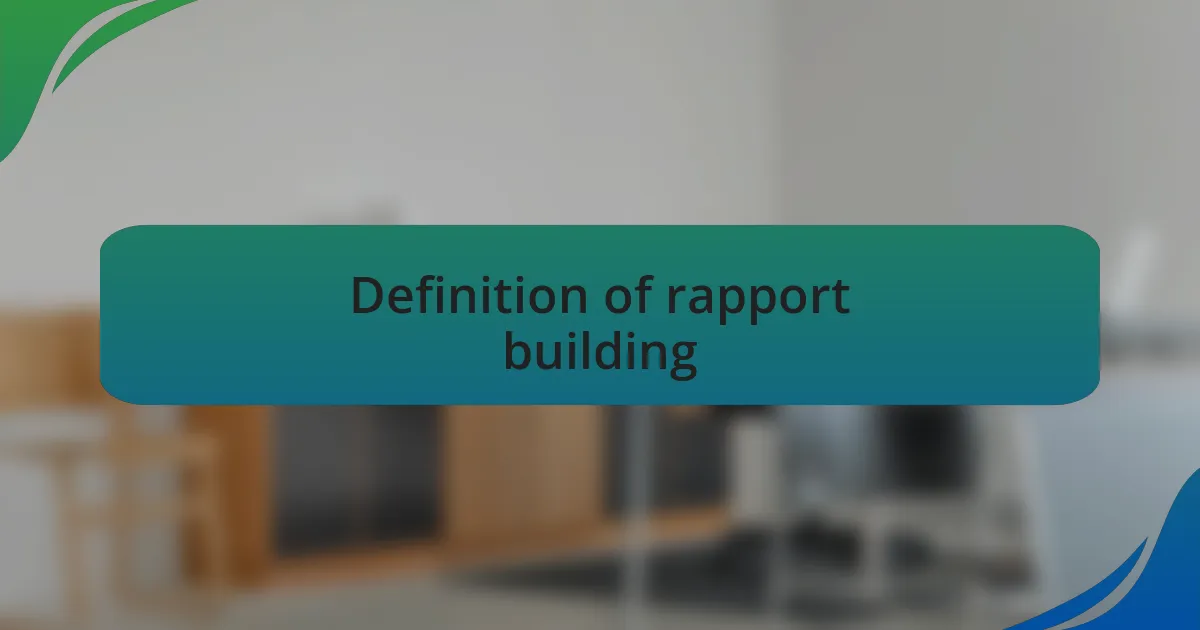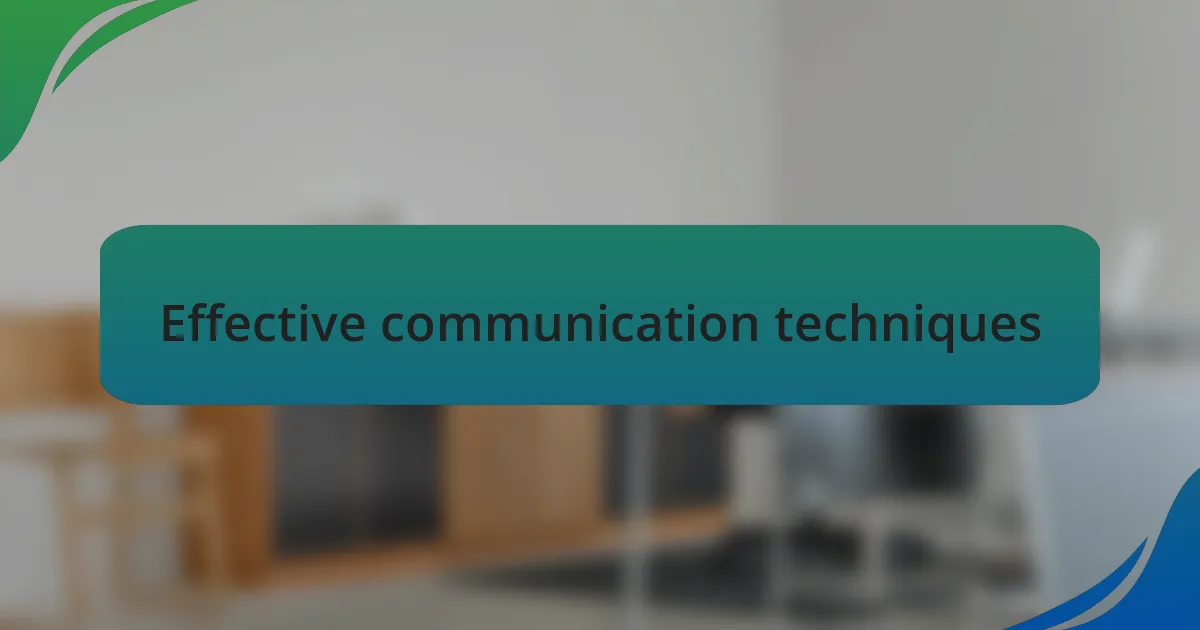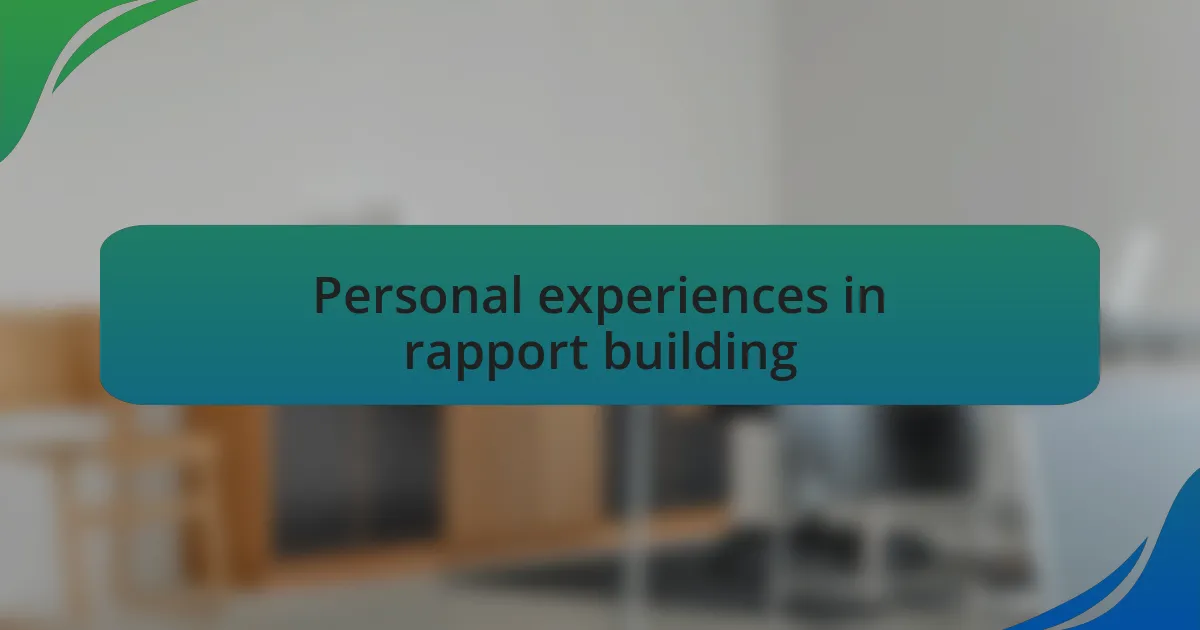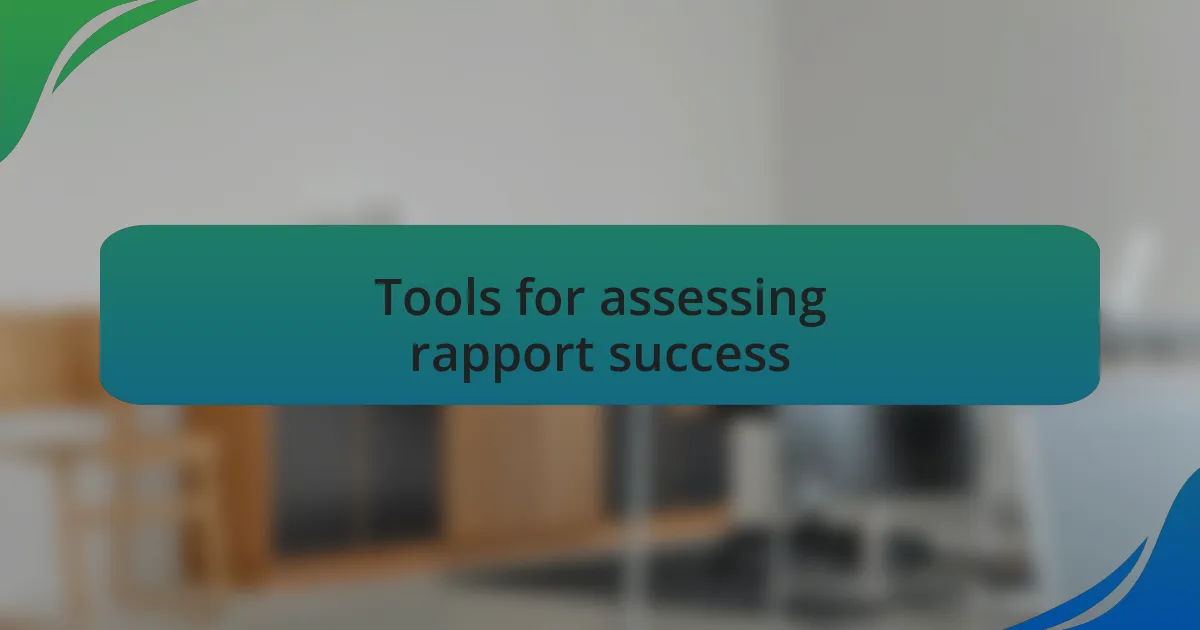Key takeaways:
- Rapport building is essential for open communication, characterized by trust and understanding.
- Key strategies for rapport include mirroring body language, sharing personal stories, and consistent follow-ups.
- Effective communication techniques such as active listening, asking open-ended questions, and expressing appreciation foster deeper connections.
- Assessing rapport success can be achieved through feedback, self-reflection, and tracking follow-up responses.

Definition of rapport building
Rapport building is fundamentally about establishing a connection with others, characterized by trust and understanding. It’s more than just a social nicety; it’s the foundation that allows for open communication and collaboration. Without it, how can we truly share ideas and foster an environment where everyone feels valued?
In my experience, rapport building feels like creating a bridge between two different sides, where both parties can meet on common ground. I remember a time when I reached out to a potential partner, and rather than jumping straight into business talk, I started by asking about their interests. That simple act opened the door to real conversation, turning what could have been a formal interaction into a collaborative partnership.
What often surprises me is the ease with which rapport can be built when we genuinely listen and show empathy. Have you ever felt more engaged when someone simply took the time to acknowledge your perspective? That’s the essence of rapport. It’s a dance of mutual respect and shared experiences that promotes not just relationships but also understanding in both personal and professional realms.

Key strategies for building rapport
One key strategy I’ve found effective in building rapport is the practice of mirroring body language. When I consciously match the gestures, tone, or pace of speech of the person I’m communicating with, it subtly creates a sense of unity. I recall a networking event where I noticed how my relaxed posture encouraged others to open up; it was fascinating to watch this mirroring effect unfold in real-time.
Another powerful tool is sharing personal stories relevant to the conversation. For instance, while discussing challenges in a project, I once shared a failure I faced and how I overcame it. This honesty not only broke down barriers but also sparked a deeper conversation about resilience and growth. It made me wonder—do we often underestimate the power of vulnerability in fostering connections?
Lastly, consistency in follow-ups reinforces the rapport we build. After meeting someone, I make it a point to drop them a quick message about something we discussed, even if it’s just a simple “how did that project turn out for you?” It shows that I genuinely care about maintaining our connection. Have you ever noticed how a small gesture can make someone feel like they matter? It’s these little efforts that keep the lines of communication open and relationships thriving.

Effective communication techniques
Engaging in active listening is a communication technique I find invaluable. It’s not just about hearing words; it’s about paying genuine attention to the speaker. I remember a moment during a discussion where I noticed a colleague’s hesitation. By giving them my undivided focus and nodding in encouragement, they began to elaborate, revealing insights that hadn’t surfaced before. Have you ever realized how simply being present can lead to richer conversations?
Another approach that resonates with me is asking open-ended questions. Instead of yes-or-no queries, I prefer to pose questions that invite elaboration. For example, I frequently ask, “What challenges are you facing in your current project?” This approach not only shows my interest but also opens the door for deeper dialogue. I’ve found that when I frame my questions in this way, it encourages a sense of collaboration rather than just a checklist of tasks.
Moreover, expressing appreciation can be a simple yet effective technique. I always try to acknowledge contributions, whether in a meeting or during casual interactions. Recently, I complimented a team member for their insightful input. The way their face lit up was a clear reminder of how affirmation fosters a positive environment. Isn’t it amazing how words of encouragement can uplift someone’s day and strengthen our connections?

Personal experiences in rapport building
Building rapport often takes me back to my days of networking at industry events. I recall feeling nervous when approaching strangers, but I adopted a simple trick: I would find common ground based on our backgrounds or interests. During one such encounter, I mentioned a shared love for a specific book, instantly bridging the gap. That moment taught me that these little connections can turn strangers into allies, making interactions feel more genuine and relaxed.
Another personal experience that stands out involves a miscommunication that could have derailed my rapport with a vendor. Instead of brushing it aside, I took the initiative to apologize and clarify my intentions openly. This vulnerability not only repaired the relationship but deepened it. Have you ever found that admitting a mistake can actually enhance trust? In my case, it transformed an awkward situation into a learning opportunity for both of us.
Lastly, I’ve learned the power of storytelling in connecting with others. Sharing my journey, including failures, makes me relatable and approachable. I remember sharing a challenging project experience with a new client. By illustrating my struggles and what I learned, they opened up about their own challenges, leading to a strong partnership founded on mutual understanding. Isn’t it fascinating how opening up can invite others to do the same?

Tools for assessing rapport success
When assessing rapport success, one tool I find invaluable is feedback. After a conversation or meeting, I often ask peers or clients for their impressions. This straightforward approach not only provides insights into how well I connected but also emphasizes my commitment to improving those interactions. Have you ever asked someone how they felt after a discussion? It can be enlightening.
Another effective method I’ve used is self-reflection. After networking events, I take a moment to jot down my experiences, including what felt natural and what didn’t. This practice helps me identify patterns in my interactions. I often wonder: what worked well in establishing a connection? Reflecting deeply can reveal surprising insights about my communication style.
Lastly, I’ve benefited from utilizing simple metrics like follow-up responses. When I send a follow-up email, I track how quickly and enthusiastically my contacts reply. A quick response often indicates a successful connection, while delayed or lackluster replies can signal room for improvement. Have you noticed how some people engage more actively after a conversation? It’s a telling sign of effective rapport-building.